多元函数拟合。如 电视机和收音机价格多销售额的影响,此时自变量有两个。
python 解法:
|
1
2
3
4
5
6
7
8
9
10
11
12
13
14
15
16
17
18
19
20
21
22
23
24
25
26
27
28
|
import numpy as npimport pandas as pd#import statsmodels.api as sm #方法一import statsmodels.formula.api as smf #方法二import matplotlib.pyplot as pltfrom mpl_toolkits.mplot3d import axes3d df = pd.read_csv('http://www-bcf.usc.edu/~gareth/isl/advertising.csv', index_col=0)x = df[['tv', 'radio']]y = df['sales'] #est = sm.ols(y, sm.add_constant(x)).fit() #方法一est = smf.ols(formula='sales ~ tv + radio', data=df).fit() #方法二y_pred = est.predict(x) df['sales_pred'] = y_predprint(df)print(est.summary()) #回归结果print(est.params) #系数 fig = plt.figure()ax = fig.add_subplot(111, projection='3d') #ax = axes3d(fig)ax.scatter(x['tv'], x['radio'], y, c='b', marker='o')ax.scatter(x['tv'], x['radio'], y_pred, c='r', marker='+')ax.set_xlabel('x label')ax.set_ylabel('y label')ax.set_zlabel('z label')plt.show() |
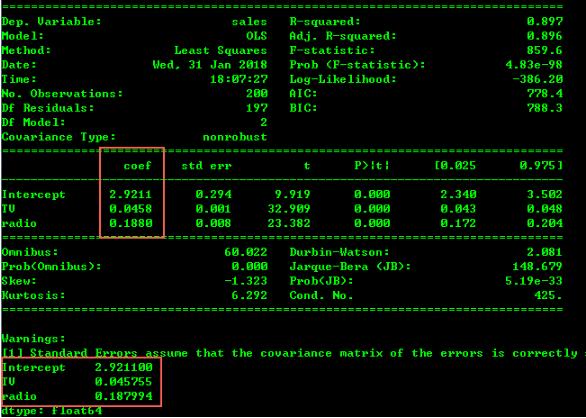
拟合的各项评估结果和参数都打印出来了,其中结果函数为:
f(sales) = β0 + β1*[tv] + β2*[radio]
f(sales) = 2.9211 + 0.0458 * [tv] + 0.188 * [radio]
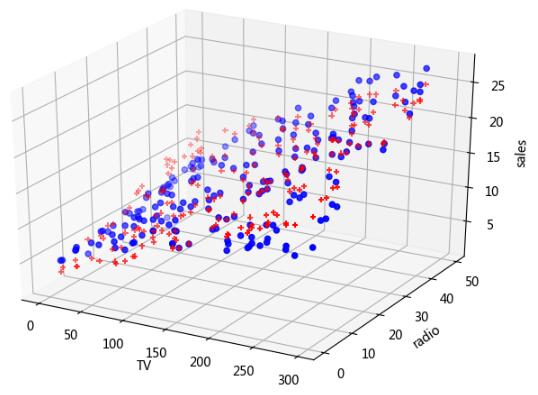
图中,sales 方向上,蓝色点为原 sales 实际值,红色点为拟合函数计算出来的值。其实误差并不大,部分数据如下。
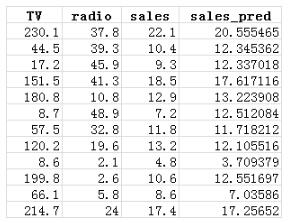
同样可拟合一元函数;
|
1
2
3
4
5
6
7
8
9
10
11
12
13
14
15
16
17
18
|
import numpy as npimport pandas as pdimport statsmodels.formula.api as smfimport matplotlib.pyplot as pltfrom mpl_toolkits.mplot3d import axes3d df = pd.read_csv('http://www-bcf.usc.edu/~gareth/isl/advertising.csv', index_col=0)x = df['tv']y = df['sales'] est = smf.ols(formula='sales ~ tv ', data=df).fit()y_pred = est.predict(x)print(est.summary())fig = plt.figure()ax = fig.add_subplot(111)ax.scatter(x, y, c='b')ax.plot(x, y_pred, c='r')plt.show() |
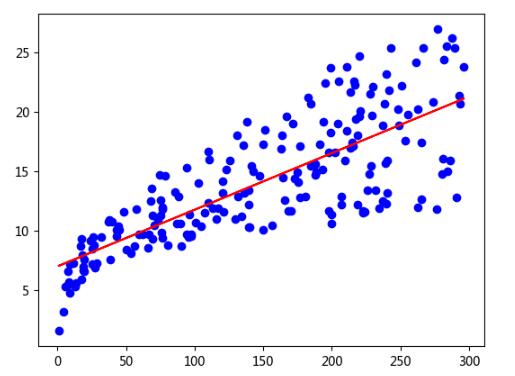
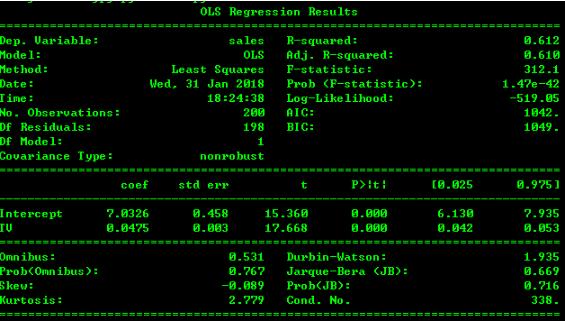
ridge regression:(岭回归交叉验证)
岭回归(ridge regression, tikhonov regularization)是一种专用于共线性数据分析的有偏估计回归方法,实质上是一种改良的最小二乘估计法,通过放弃最小二乘法的无偏性,以损失部分信息、降低精度为代价获得回归系数更为符合实际、更可靠的回归方法,对病态数据的拟合要强于最小二乘法。通常岭回归方程的r平方值会稍低于普通回归分析,但回归系数的显著性往往明显高于普通回归,在存在共线性问题和病态数据偏多的研究中有较大的实用价值。
|
1
2
3
4
5
6
7
8
9
10
11
12
13
14
15
16
17
18
19
20
21
22
23
24
|
import numpy as npimport pandas as pdimport matplotlib.pyplot as pltfrom sklearn import linear_modelfrom mpl_toolkits.mplot3d import axes3d df = pd.read_csv('http://www-bcf.usc.edu/~gareth/isl/advertising.csv', index_col=0)x = np.asarray(df[['tv', 'radio']])y = np.asarray(df['sales']) clf = linear_model.ridgecv(alphas=[i+1 for i in np.arange(200.0)]).fit(x, y)y_pred = clf.predict(x)df['sales_pred'] = y_predprint(df)print("alpha=%s, 常数=%.2f, 系数=%s" % (clf.alpha_ ,clf.intercept_,clf.coef_)) fig = plt.figure()ax = fig.add_subplot(111, projection='3d')ax.scatter(df['tv'], df['radio'], y, c='b', marker='o')ax.scatter(df['tv'], df['radio'], y_pred, c='r', marker='+')ax.set_xlabel('tv')ax.set_ylabel('radio')ax.set_zlabel('sales')plt.show() |
输出结果:alpha=150.0, 常数=2.94, 系数=[ 0.04575621 0.18735312]
以上这篇python 普通最小二乘法(ols)进行多项式拟合的方法就是小编分享给大家的全部内容了,希望能给大家一个参考,也希望大家多多支持服务器之家。
原文链接:https://blog.csdn.net/kk185800961/article/details/79220724










